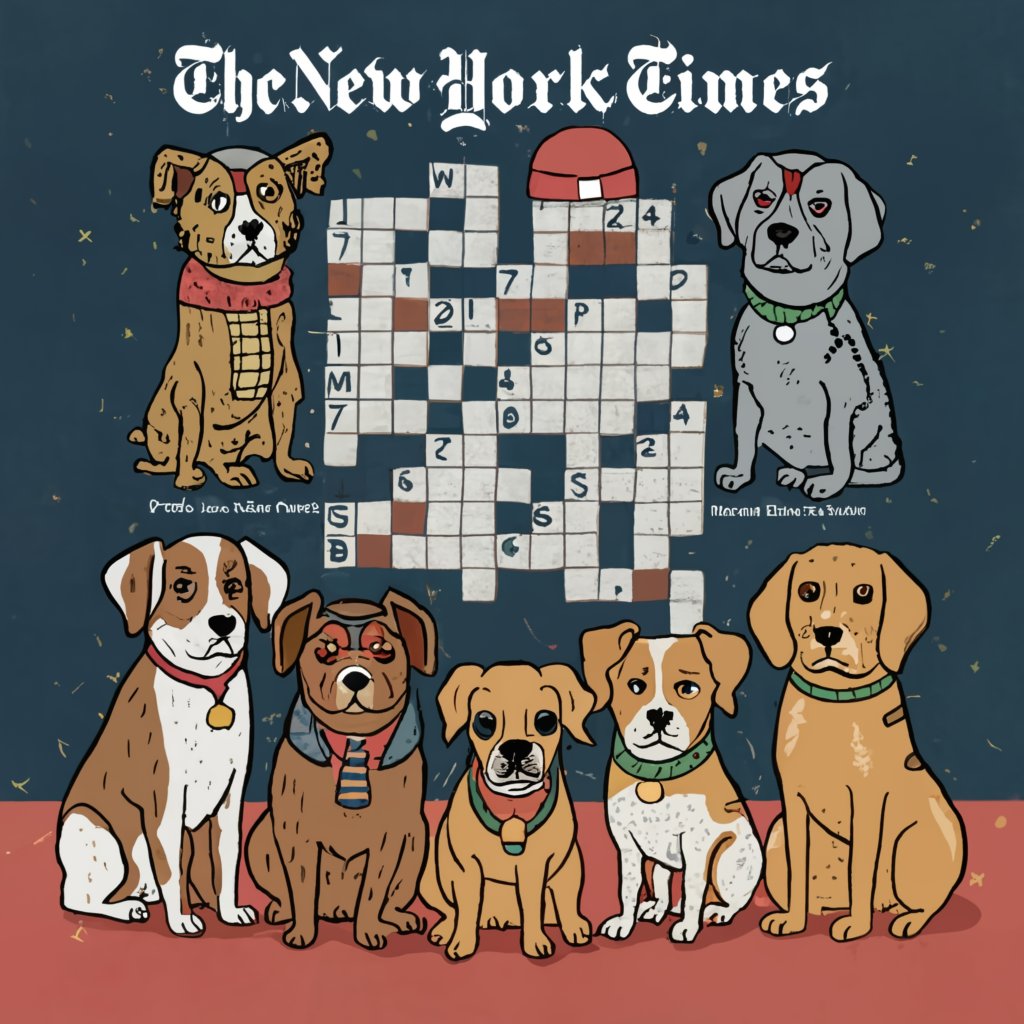If you’ve ever found yourself scratching your head over a crossword puzzle, you’re not alone. The New York Times Crossword is a beloved pastime for millions, but when it comes to canine-themed clues, many puzzle enthusiasts can find themselves at a loss. Enter the “Canine Handler NYT Crossword,” where dog lovers and wordsmiths unite! This delightful niche of the crossword world celebrates our four-legged friends while challenging your wits.
Whether you’re an experienced handler or just someone who enjoys spending time with dogs, this crossword has something special in store for you. It’s more than just solving clues; it’s about unleashing creativity and tapping into your love for dogs. Get ready as we explore the fascinating connection between canine handlers and crossword puzzles—leading to solutions that are sure to fetch some smiles!
History of Crossword Puzzles and the NYT Crossword
Crossword puzzles have a rich history that dates back to the early 20th century. The first known crossword appeared in a New York newspaper in 1913, crafted by Arthur Wynne. This simple word game quickly captured the public’s imagination.
The New York Times introduced its own version in 1942, marking a significant milestone for crossword enthusiasts. Initially published on Sundays, it soon became a daily feature due to its popularity.
What sets the NYT Crossword apart is its clever clues and cultural references. Each puzzle reflects contemporary life and language trends, often challenging solvers with wit and nuance.
Over time, it evolved into an art form of sorts—drawing contributions from talented constructors who push creative boundaries while keeping traditional formats intact. As the years passed, this beloved pastime gained traction across generations, solidifying its place in American culture.
The Role of Canine Handlers in Solving the Puzzle
Canine handlers play a fascinating role in the world of crossword puzzles. Their unique insights into dog behavior, breeds, and training techniques often translate into clever clues and answers.
When tackling canine-themed crosswords, these experts bring their knowledge to the table. They identify common themes relating to dogs that might stump casual solvers.
Handlers are adept at spotting nuances in language as well. A hint about a specific breed or training command can unlock potential solutions quickly.
Their experience with various canine-related scenarios arms them with an arsenal of terminology too. This fluency helps them navigate tricky clues that might leave others scratching their heads.
Plus, handlers possess patience—a key trait for both working with dogs and solving intricate puzzles like those found in the NYT Crossword. This dual skill set allows them to approach challenges methodically and creatively.
Tips and Tricks for Successfully Completing the Canine Handler NYT Crossword
To tackle the Canine Handler NYT Crossword effectively, start by scanning for familiar dog-related terms. These often serve as anchors to build around.
Next, pay attention to word lengths listed in the clues. This can help you narrow down possible answers quickly and efficiently.
Don’t overlook crosswordese — those quirky words that pop up frequently in puzzles. Being aware of common short forms or abbreviations related to canine culture will give you an advantage.
Try filling in easy clues first. Gaining momentum with straightforward answers builds confidence and helps unlock tougher sections later on.
Also, consider using a pen instead of a pencil if you’re feeling bold! Committing could spark your creativity and push you to explore more unusual ideas without second-guessing yourself constantly.
Engage with fellow solvers online or at local groups; sharing insights can reveal strategies you hadn’t considered before.
Common Themes and Clues in the Puzzle
When diving into the Canine Handler NYT Crossword, you’ll quickly notice recurring themes. Dogs are not just pets; they often symbolize loyalty, companionship, and service.
Expect clues that nod to various dog breeds like beagles or retrievers. These hints can evoke fond memories of four-legged friends in everyday life.
Then there are terms related to canine training and behavior. Words such as “sit,” “stay,” or “fetch” frequently pop up.
Handlers themselves also take center stage. Clues might reference their vital roles in police work or search-and-rescue missions.
The playful nature of dogs lends a light-hearted touch to these puzzles. They invite solvers to explore the whimsical side of canine culture while engaging both wit and knowledge about our furry companions.
Testimonials from Experienced Canine Handlers
Many experienced canine handlers have shared their insights on the challenges of the NYT Crossword. Their perspectives reveal a fascinating connection between dog training and puzzle-solving.
“Crosswords sharpen my focus,” says Sarah, a handler for therapy dogs. “Just like with my dogs, I need patience and strategy.”
Mark, who trains search-and-rescue pups, emphasizes teamwork: “Every clue is like working with a new dog; you learn their cues over time.”
These handlers highlight the joy found in both realms. As Emily notes, “Solving puzzles offers mental stimulation similar to enriching a dog’s environment.”
Their experiences intertwine discipline and creativity. The thrill of uncovering answers mirrors that moment when your pup nails a command after weeks of practice. It’s clear—canine handling isn’t just about the dogs; it’s also about honing skills that translate beautifully into crossword success.
Understanding the Role of a Canine Handler
Canine handlers play a vital role in various fields, including law enforcement, search and rescue, therapy, and service work. Their bond with dogs goes beyond mere training; it’s about trust and communication.
These individuals are responsible for the well-being of their canine partners. They ensure that their dogs are fit, healthy, and ready to perform tasks effectively. This involves regular exercise, mental stimulation, and consistent training sessions.
Handlers also interpret the behavior of their dogs. Recognizing signals can mean the difference between success or failure in critical situations. A dog may alert its handler to potential danger or even find a missing person based on its instincts.
The relationship is built over time through bonding exercises and shared experiences. Together they become an unstoppable team capable of tackling challenges that neither could face alone.
Popular Dog Breeds Featured in Crosswords
When diving into the Canine Handler NYT Crossword, you’ll often stumble upon clues featuring popular dog breeds. These furry friends not only bring joy to our lives but also add a playful twist to puzzle-solving.
Breeds like “poodle,” known for their intelligence and elegance, frequently pop up. Their unique spelling can sometimes trip you up if you’re not careful!
Then there’s the ever-popular “beagle.” This breed is renowned for its keen sense of smell and friendly demeanor. A perfect fit for crossword clues that highlight loyalty or hunting instincts.
Don’t overlook the “bulldog,” either! With their distinctive looks and gentle nature, they’ve cemented themselves as a favorite in both homes and puzzles alike.
These dogs enrich crosswords with charm while giving solvers delightful ‘aha!’ moments when those answers click into place.
Tips for Solving Canine-Themed Crossword Clues
When tackling canine-themed crossword clues, start by thinking about popular dog breeds. “Beagle” and “Poodle” often make appearances. Familiarizing yourself with these names can give you an edge.
Next, consider common terms associated with dogs. Words like “bark,” “fetch,” or “leash” frequently pop up in puzzles. These simple yet effective clues can unlock tricky sections.
Wordplay is also key in crosswords. Puns or double meanings related to dogs may lead you astray or illuminate the path forward.
Remember, context matters! Clues might refer to famous movie dogs, so keep an eye on cultural references as well.
Don’t hesitate to collaborate with friends who share your love for puzzles and pups. Discussing ideas can spark creativity and yield surprising solutions that enhance your solving experience.
Historical Context of Canine Handlers
Canine handlers have played a vital role throughout history, especially in military and law enforcement settings. Their partnership with dogs dates back centuries, where these animals were trained for various tasks beyond companionship.
In ancient times, dogs served as guardians and hunters. The bond between humans and canines deepened during World War I when they helped locate wounded soldiers. These brave pups became essential to the war effort.
During the 20th century, police departments began recognizing the value of canine units. Dogs assisted in searching for drugs, explosives, and missing persons. This evolution showcased their intelligence and loyalty.
Today’s canine handlers are highly trained professionals who understand animal behavior. They adapt training techniques to each dog’s unique traits while ensuring public safety through their work alongside these remarkable animals.
Notable Crosswords Featuring Dog-Related Terms
Crossword enthusiasts often find joy in solving clues that center around our four-legged friends. The New York Times has featured numerous puzzles showcasing dog-related terms, which adds an extra layer of fun.
One memorable crossword included the clue “Famous beagle,” leading to the popular answer “Snoopy.” This beloved character resonates with many, making it a favorite among solvers.
Another standout puzzle featured “Canine companion” as a clue for “Pooch.” Such friendly references not only entertain but also evoke smiles from those who love dogs.
Some crosswords even incorporate terms like “dog park” or “puppy love,” connecting the answers directly to real-life experiences. These delightful snippets remind us of the special bond we share with our pets and how they can brighten up any day spent tackling word challenges.
Strategies for Tackling NYT Crossword Challenges
Crossword puzzles can be daunting, especially the NYT ones. But with the right strategies, you can tackle them like a pro.
Start by scanning for easy clues. Quick wins build confidence and create momentum.
Next, focus on fill-in-the-blank questions—they often provide hints that lead to other answers.
Don’t hesitate to skip tough clues temporarily. Circle them and return later with fresh eyes; sometimes answers come when least expected.
Use a pencil! This allows for quick changes without frustration. Erasing is part of the process.
Familiarize yourself with common crossword lingo too—abbreviations and recurring themes appear frequently.
Practice makes perfect. The more crosswords you attempt, the better you’ll understand their nuances and patterns. Engage your brain regularly, and soon those challenges will feel less intimidating!
The Importance of Canine Handlers in Various Fields
Canine handlers play a vital role across multiple fields. Their expertise enhances public safety, as seen in law enforcement and search-and-rescue operations. Dogs are trained to detect drugs, explosives, and even missing persons.
In therapy settings, canine handlers facilitate emotional support through specially trained dogs. These teams can help individuals cope with anxiety, PTSD, or other mental health challenges.
Moreover, the importance of canine handlers extends into education. They often participate in reading programs where children read aloud to dogs. This not only boosts confidence but also fosters a love for learning.
Service animals provide indispensable assistance to those with disabilities. Handlers ensure these animals perform tasks that improve their owners’ quality of life daily.
Across these diverse sectors, the bond between handler and dog is essential. It underscores the unique capabilities that canines bring to human endeavors everywhere.
Fun Facts About Dogs in Puzzles and Games
Did you know that dogs have been a popular subject in puzzles for decades? They often symbolize loyalty and companionship, making them a favorite among crossword creators.
In many classic crossword themes, dog breeds like “Beagle” or “Poodle” frequently make an appearance. These clues not only challenge solvers but also spark joy for dog lovers.
Games featuring dogs go beyond crosswords too. Think about Scrabble or trivia games where canine-related terms can rack up points. It’s fascinating how these furry friends infiltrate various forms of entertainment.
Moreover, certain companies even produce puzzle books solely dedicated to our four-legged pals. These collections include word searches and Sudoku with doggie twists!
Dogs add personality and warmth to the world of puzzles and games, reminding us why we love them so much while we engage our minds.
Community Insights: Solving Together
Crossword solving can often feel like a solitary endeavor. However, the magic happens when enthusiasts come together to share their insights and strategies.
Online forums and local clubs provide platforms where crossword lovers discuss clues, brainstorm solutions, and celebrate their victories. This collective energy transforms puzzle-solving from a simple pastime into an engaging social experience.
Participants often reveal unique approaches to tricky canine-themed clues in the Canine Handler NYT Crossword. These discussions spark creativity and encourage out-of-the-box thinking.
Moreover, community members frequently exchange tips on resources that enhance skills or tackle specific puzzles more effectively. The camaraderie built during these interactions fosters not just friendships but also a deeper appreciation for crosswords as an art form.
Every shared insight enriches the solving journey, reminding everyone that collaboration can lead to greater success than going it alone. Engaging with others makes each puzzle even more rewarding.
Resources for Crossword Enthusiasts
For crossword enthusiasts, there’s a treasure trove of resources available to enhance solving skills. Websites like Crossword Nexus and XWord Info offer extensive databases for previous puzzles, allowing solvers to explore patterns and themes.
Mobile apps such as NYT Crossword App provide daily challenges right at your fingertips. These platforms often feature hints or reveal letters as you progress, which can be incredibly helpful when facing tricky clues.
Books dedicated to crosswords are also valuable assets. Titles like “The New York Times Crosswords for Young Solvers” introduce newbies to the world of puzzles in an engaging way.
Online forums and social media groups create vibrant communities where fans share tips, tricks, and favorite clues. Connecting with fellow enthusiasts can make the journey even more enjoyable while providing support when tackling challenging grids.
Conclusion: Unleash Your Inner Solver with the Canine Handler NYT Crossword!
Embrace the challenge of the Canine Handler NYT Crossword. This puzzle is more than just a test; it’s an adventure in wordplay and canine culture.
Each clue invites you to tap into your knowledge about dogs, from breeds to behavior. It’s a delightful journey that sharpens your mind while celebrating our furry friends.
As you tackle each answer, think of it as training your brain—just like a dog learns new tricks. The satisfaction of solving those tricky clues can be as rewarding as teaching a pup to fetch.
So grab your pencil or digital device and dive in! Unleashing creativity and curiosity awaits with every crossword filled in. Your skills will grow with practice, making each session enjoyable yet challenging. Embrace this unique twist on classic puzzles, where dogs lead the way through clever wordplay.
FAQs
What is a canine handler in the context of crossword puzzles?
A canine handler typically refers to someone who works with dogs for various purposes, like training or search and rescue. In crosswords, it may hint at specific dog-related terms or themes.
Why is the Canine Handler NYT Crossword popular?
The popularity stems from its engaging clues that resonate with dog lovers and puzzle enthusiasts alike. It’s a fun way to celebrate our furry friends while exercising your brain.
How can I improve my skills in solving the Canine Handler NYT Crossword?
Practice regularly by tackling different puzzles. Familiarize yourself with common canine-themed words and phrases. Joining online communities can also provide valuable tips.
Are there specific breeds commonly featured in these puzzles?
Yes, breeds like Labrador Retriever, Beagle, Golden Retriever, and Poodle often appear due to their popularity and cultural significance.
Can I collaborate with others when working on this crossword?
Absolutely! Many people enjoy solving crosswords together as it promotes teamwork and shared insights. Online forums are great places to connect with fellow enthusiasts.
Is there a certain time frame for completing the Canine Handler NYT Crossword?
While there’s no strict deadline for completion, many solvers aim to finish within an hour or so during their regular routine on publication days—typically Sundays!
Do you have any recommendations for resources on crossword-solving strategies?
There are numerous books dedicated to crossword techniques along with websites offering practice puzzles tailored for all skill levels. Engaging in forums can also enhance your knowledge through community sharing.
With these insights about the Canine Handler NYT Crossword at hand, you’re ready to tackle those tricky clues effectively! Happy puzzling!
FOR FURTHER INFORMATION VISIT: BUIENRADAR.CO.UK











